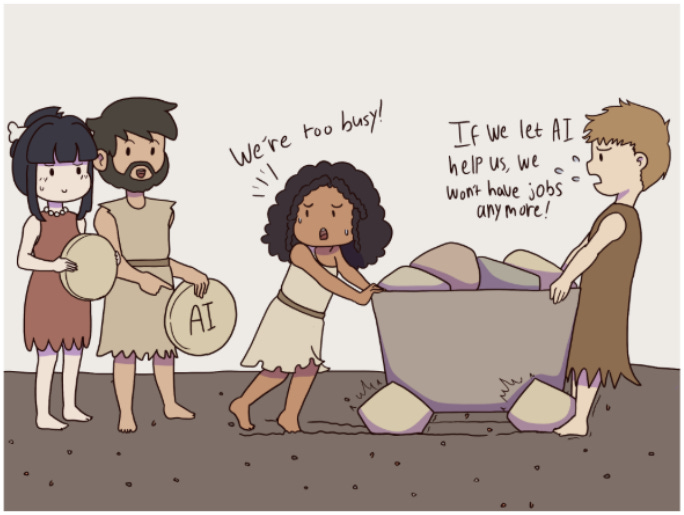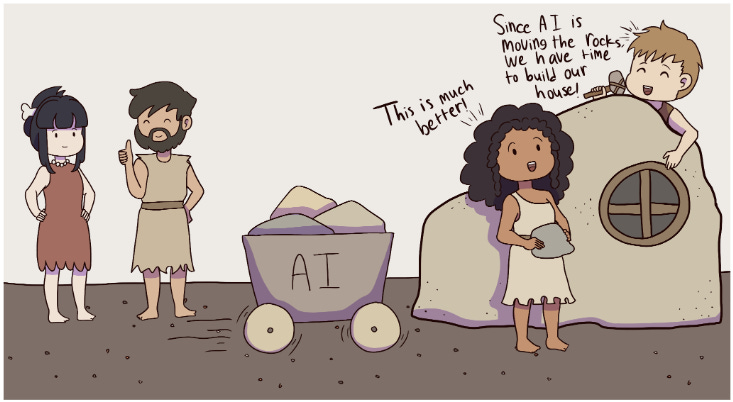There’s something that’s been bugging me for a while now when I’m talking about using AI. It’s not the objections to the environmental impact (though that’s concerning), nor the inherent biases (definitely worrisome). No, not the overwhelming feeling of “where do I start” (though that’s a biggie, too).
It’s not any of those things. It’s the image above1 … the constant demand of deadlines, to-do lists, emails, meetings, and more. There are dozens of metaphors: tying your shoes before running a race, not letting grandma’s china hit the floor when spinning plates on Ed Sullivan2, keeping one’s nostrils above the waves.
Sound familiar?
I've been thinking about this image a lot lately, especially when I talk to nonprofits about AI. The potential is obvious—draft that grant report in 20 minutes instead of a couple of days, turn meeting transcripts into action items automatically, brainstorm campaign ideas when you're stuck at 2pm on a Thursday. But actually making the switch? Finding the bandwidth to figure out which tools work, how to use them responsibly …
How in the world can you find time just to get started?
That's where it gets complicated.
This isn't another "AI will save us all" article. (Please call me out if I ever write one of those!) This is for all of you who are pushing the cart and know there's a better way, but can't figure out how to make the change to the new way without falling desperately behind.
Leadership Goes First
Here's what I've learned from watching organizations actually make this transition work: it starts with leadership making a public commitment. Not a vague "we really need an AI adoption plan" comment in a staff meeting, but an actual, specific promise.
Try this on, leaders among our readers: "By December 1st, we're going to be using AI tools to cut our weekly leadership update meeting from two hours to 30 minutes and the prep time to less than 20 minutes for each department. I'm giving Maya and Josh four hours a week for the next two months to figure this out, and I'll be checking in with them every other Friday and personally finding help when they need it."
Notice what she did there? She got specific about the outcome, named the people, allocated the time, and committed to both personal support and regular check-ins.
That's not just an announcement—it's a promise with scaffolding.
The timeline might look like this:
Month 1: Announce the initiative; Maya and Josh start exploring tools during their allocated time
Month 2: They pilot a couple of AI tools with real program data (with proper privacy protections, of course)
Month 3: If they’re ready, they roll out the solution and train the rest of the team
Here's the thing leadership often misses: you're not just giving permission to try new tools. You're giving permission to fail, to spend time learning something that might not work, to prioritize innovation over the immediate urgent task. That's actually pretty radical, but the payoffs can be enormous.
Get Help (Seriously, Don't Go It Alone)
Can I tell you a secret? Some of the best AI implementations I've seen started with spending a couple of hours on a call with a knowledgeable volunteer.
I know, I know. You're thinking, "Great, another thing to manage—finding and onboarding a volunteer." But hear me out. There are incredible platforms—Tech To The Rescue, Taproot Plus, Catchafire—they're not just throwing random people at you. They're matching you with folks who've been down this road before.
You don't need a perfect plan. You need a good-enough plan to start moving. And sometimes the best way to get that is to borrow someone else's brain for a few hours.
And then if you see the possibility of scoping and chartering a project, these organizations can help there, too. I’ve been involved with all three (and still am)3, and I can vouch that if you can invest the time from your side, you’ll be delighted with the leaps forward you can make with a dedicated, skilled volunteer. Don’t skip past that “if” though: you need to be ready to find that precious time to be sure that you’re fully engaged in jointly creating a successful project.
That said, here's the thing about outside help—it's most effective when you've got the right people on your team ready to run with what you learn. That consultant can help you craft the roadmap, but someone internal needs to drive the car.
Find Your Tinkerers
Every organization has them—the people who figured out how to make your CRM work, who created that Excel formula that everyone croons over, who somehow always know the keyboard shortcut you need. They're not necessarily your IT people. They're your curiosity people.
Give them permission to play.
Tell them that they should try stuff, document what works, and share what they learn. No pressure to find the perfect solution immediately.
A few things to keep in mind as your tinkerers explore:
Privacy first: Before trying any tool, ask what happens to your data. If the answer isn't clear, don't upload real client information.
Start small: Don't try to revolutionize everything at once. Pick one annoying task and see if AI can make it less annoying.
Document everything: What they tried, what worked, what didn't, what questions came up. Trust me, everyone will appreciate it down the road.
The Reality Check
So, I know many of you are thinking. "This sounds great in theory, but we're barely keeping our heads above water as it is. How are we supposed to find time for experimentation?"
Fair point. And honestly? Some organizations aren't ready for this yet. If you're in crisis mode, if your staff is completely burned out, if you don't have basic systems in place—maybe this isn't your year for AI adoption. That's okay.
But if you're like many organizations—functioning but inefficient, managing but not thriving—then the question isn't whether you can afford to spend time on this. It's whether you can afford not to.
Because here's the thing about square wheels: they'll get you where you're going, eventually. But they'll also wear out your team, slow down your progress, and make every mile harder than it needs to be.
AI isn't magic. It's not going to solve all your problems or eliminate the need for human judgment and creativity. What it can do is take some of the friction out of the repetitive, time-consuming tasks that keep you from focusing on the work that really matters.
Making the Switch
So, where do you start? Right here:
Next week: Have a leadership conversation. What are the 2-3 most time-consuming, repetitive tasks your organization does regularly? Be specific.
The following week: Identify a couple of staff members who are naturally curious about trying new approaches. Ask if they're interested in exploring solutions.
Before the end of the month: Give those staff members some protected time to research and experiment. Set up regular check-ins. Find advisory help if you need it.
And soon: You try something small. Document what happens. Share what you learn. The more public (within your organization), the better—the good, the bad, the ugly. The fun and the frustrating. It doesn’t matter so much how successful you are. It’s that you “get it” enough to have taken your precious time to give it a shot. And you’ll have the bonus of a shared experience with your tinkerers. And who knows, you may resemble the septuagenarian CEO of a social service nonprofit who spent a few hours with ChatGPT last spring brainstorming ideas for a grant proposal and told me that her “weekend melted away.”
You're not committing to a complete organizational overhaul. You're committing to swapping out one set of square wheels for round ones. Then maybe another set. Then another.
Change happens one wheel at a time.
Make Good Choices
As you think about moving forward, remember that the most powerful choice you can make is how you spend your attention and time … and then that of your team. Choose tools that align with your values. Choose experiments that serve your mission. And choose to give your team the space to learn and grow.
The cart will keep moving either way. The question is whether you want to keep fighting the square wheels or whether you're ready to try something smoother.
Many thanks to Kim Snyder and Joshua Peskay of RoundTable Technology, who give fantastic presentations about AI, cybersecurity, and more. Always informative. Always candid. And always very entertaining!
I often have used the “spinning plates” metaphor as a shorthand to be sure a team is keeping its eye on the important things. Think of spinning paper plates, the daily Corelle (if you remember what that is!), and grandma’s china. No problem if the paper plates or Corelle hit the floor, but oh my, if one of grandma’s china plates shatters, you’ll never want to sit at the Thanksgiving table again! And in case you have NO IDEA what I’m talking about, check out this video.
And very sincerely, if you want to pick my brain about these organizations or even just how to get going, let’s talk! Just put half an hour or an hour on my calendar: https://bit.ly/MeetWithDeb.







This is so actionable and clear. I want to be a volunteer!